28 Chinese
History Observed: Joseph Beuys & Mao Zedong
2007
From the series Rent-Rent Collection Yard
By Li Zhanyang(Chinese, b. 1969)
Fiberglass, resin, and paint
This sculpture is part of a series by Li Zhanyang that takes its cue from Rent Collection Courtyard, a group of Social Realist sculptures from 1965 that has become a symbol of China's Cultural Revolution. One hundred and fourteen clay figures represent class conflict between poor farmers and ruling landlords before the Communist Party came to power. The figures were commissioned by the provincial government of Sichuan and permanently displayed inside one landlord's courtyard as a reminder of oppression under imperial rule.
This sculpture is one example from Li Zhanyang's series Rent-Rent Collection Yard that mimics the 1965 work to give a humorous and candid look at today's Chinese contemporary art scene. Li's version replaces farmers and landlords with real-life art world players, from artists to gallerists to collectors and international celebrities. We see Chairman Mao in a chair. Behind him is Joseph Beuys (1921–1986), an influential German artist who believed that art could shape society and politics. It shows the men as spectators of other works in Li Zhanyang's series, with Beuys explaining to the Chairman the art world drama being played out before them.
"I think [Joseph Beuys] is the most powerful conceptual artist in the Western world; his art is philosophical. Mao Zedong, in a sense, is also a big philosophical artist, his Cultural Revolution should be regarded as the largest piece of performance art in the world. The class conflict–based Cultural Revolution he started left everlasting pain for the Chinese people. . . . I used the methods of 'changing the broth but not the medicine' . . . and changed the old characters with the characters of today. I am postulating that Mao feels lost, and Beuys is explaining [Rent-Rent Collection Yard] to him." —Li Zhanyang


